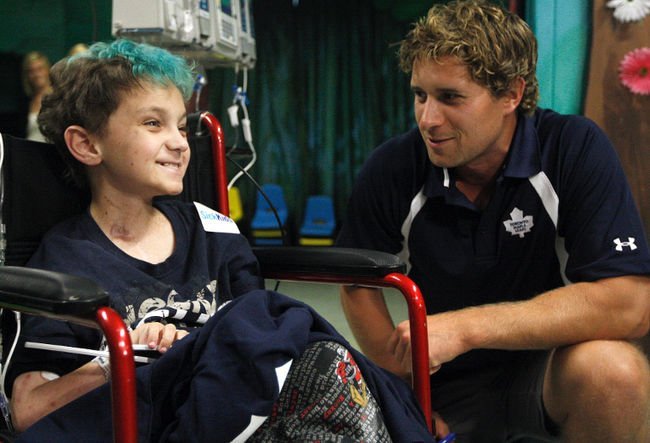
The locking up of John Michael Liles for the next four seasons further evidences Brian Burke’s team building philosophy is moving towards speed and skill and away from size and toughness.
When Burke first arrived in Toronto he quickly moved to bring in Francois Beauchemin and Mike Komisarek to join Luke Schenn as a formidable, physical trio. Not even three years later and there’s a clear group of three defensemen the Leafs are building on, but the theme is not physicality this time.
With Liles now in Toronto for the long haul, he joins, in my mind, Dion Phaneuf and Jake Gardiner as foreseeable locks on the blue line for years to come.
Almost every other defenseman in the Leafs organization – Komisarek, Schenn, Gunnarsson, Franson, Aulie, Holzer – has been rumoured to be in trade talks at some point this season and while we don’t know what that actually means in terms of how Brian Burke values these guys, it’s safe to say that he would not be opposed to moving any of them.
No matter who stays and who goes, we already know who will be eating big minutes on this team for the next little while anyways. Dion Phaneuf averages over 25 minutes a night and we can expect that to continue for at least half of the next decade. Jake Gardiner’s averaging just under 21 minutes a night this season and as long as he avoids a sophomore slump, you have to think it will only be two years until he’s averaging close to 25 minutes a night too.
We also have to wonder if the Leafs are eventually planning on having Jake Gardiner and Dion Phaneuf as their top tandem. Although some might say you can’t have two offensive players together, I say that talent plays well with other talent and figures out a way to excel together (just like when people said you can’t have two shooters – Lupul, Kessel – playing together), plus if Gardiner’s skating ability can compliment Cody Franson on a pairing, chances are that he can handle teaming up with Dion Phaneuf. The Leafs are already putting Gardiner-Phaneuf together on the ice once and awhile too.
Back to the ice time, Liles has averaged 21:32 a night in his time here so far and that will stick for the next couple of years considering his point production and new contract. That means there’s three guys who will be expected to log at least 21 minutes a night right there.
Of the 30 teams in the NHL, 14 of them have three or less defensemen who average 20 minutes or more a night. Now the Leafs are one of the 16 teams who have four defensemen above that number – Carl Gunnarsson being the other – so either we’re looking at the three guys who will carry most of the responsibility for the next while, or maybe there is one more who joins them.
In an ideal world, that fourth 20 minute defenseman is the Luke Schenn of last year. The Schenn who averaged 22:22 a night, crushed bodies, and showed some offensive potential at the end of the season that suggested he could be a guy capable of putting up 30-35 points a season. But so far in his career he’s building this on-year, off-year pattern that has to be troubling for management, especially since they signed him to a five year deal this summer.
The question on everyone’s mind is whether Leafs cash in on Schenn’s potential for either other potential or production elsewhere, or whether they ride out his development. But you also have to consider where Schenn, as the fourth 20 minute defenseman, would leave guys like Franson and Gunnarsson, who in their own right think, and are, top four defensemen; to say nothing of Keith Aulie, Mike Komisarek, Jesse Blacker and Korbinian Holzer.
As far as the Liles contract goes, they got him for below market value and he’s a player that you generally know what to expect from each season – speed, puck moving and 40-45 points a year. Most importantly though, he loves Toronto. When you’re building a team you want players who truly want to be here. Not only does it cause the player himself to work harder, but it rubs off on teammates too.
One of the hardest things to do when you’re coaching a team or managing one is getting players to buy into the program. So when you have respected NHL veterans who want to stay in Toronto because they like what’s going on, it sends a message; when new players are acquired they walk into the dressing room and either see a bunch of players who don’t care about the organization – Islanders, Columbus, etc. – or a bunch of players that do – Detroit, Philadelphia, Pittsburgh, etc. – and it creates an environment for players to excel in. That’s the reason so many GMs and coaches bring in players they are familiar with already, because those players believe in the system that’s in place and spread that sentiment throughout their teammates. It doesn’t matter how good of a coach you are if the players don’t believe in you, and no matter what you’re going to have players who doubt you. So you need to have guys that have your back in that dressing room when you aren’t around to make sure things stay in line, and the Leafs have that in a well respected veteran in Liles.
Everyone loves to bring up the organizational prowess of the Detroit Red Wings without recalling how awful they were prior to that. How did that all change? With guys like Steve Yzerman and Kris Draper, who cared about the organization and passed that torch down to guys like Pavel Datsyuk and Henrik Zetterberg. It has to start somewhere.
Since Brian Burke has gotten to Toronto, he has talked a lot about the culture in Toronto and “Blue and white disease.” When he’s bringing in veterans who love playing here and after only 34 games want to commit the next four years of their career here, he’s obviously changed that culture.
Furthermore, and this probably isn’t news to anyone, Liles serves as an excellent mentor to Jake Gardiner. Well Liles is a very good skater, Gardiner is going to be all-world. The best thing that could happen for Gardiner’s career is if he learns how to best use his speed when the puck is not on his stick. When you watch Liles play, he moves the puck quickly then hits the lane in anticipation of getting the puck back, whereas Gardiner skates the puck himself (that’s the difference between the pros and junior hockey). If he learns how to distribute it at the NHL level and create space for himself while his teammates have the puck, he’s going to be a force out on the ice and he’s going to be able to learn that from Liles for the next four years.
John-Michael also takes pressure off of Phaneuf. As we have seen lately, the power play has struggled to score, especially in big moments of games – Ottawa and Montreal come to mind. Phaneuf is a weapon on the power play because he has a big shot, but he’s incapable of quarterbacking a power play, which is what Liles does so well. On paper, the Leafs probably count on Phaneuf for 50 or so points a year, Liles 40-45 and will probably expect Gardiner to get at least 30 next season, so that’s a total of around 120-130 points from those guys. The Ottawa Senators, who have the highest scoring defense in the league, have their top trio on pace for 143 points this season.
If the question is whether Liles will be able to continue producing throughout this contract, the answer should be yes. First and foremost, Liles is an effortless skater. He’s the kind of guy who will have NHL skating ability his entire life because that’s just how he’s built. Of course, we all heard the same thing when Jason Blake was signed here, the difference now is that we’ve already seen John-Michael produce on this team and we know what he’s capable of. He’s also not coming off of a contract year 40 goal season. That’s the second thing that is important to note here, expectations are not sky-high for Liles. Nobody is thinking this guy is going to get 60 points here and that’s important in this market. He has his role set out and defined for him and nobody is asking him to do anything he is incapable of. His salary reinforces that expectation.
You can analyze the Liles contract itself all you want; at the end of the day he’s easily worth it if he’s putting up 40-45 points a year. The more interesting thing to look at is how this impacts the rest of the defense. If we’re assuming Gardiner-Phaneuf is the top tandem of the future and Liles is the second pairing left-defenseman, who is going to fill out those remaining three spots? The Leafs have made half the bed here and the rest of the sheets and pillows are lying around waiting to be placed in order. It’s up to Brian Burke and co. now to put together the best looking spread.

































